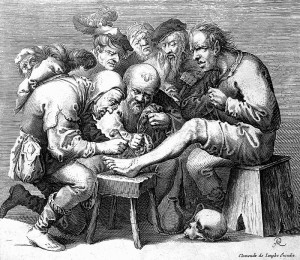Table of Contents
What is a podiatrist? What is a chiropodist?
There was a time when podiatrists and chiropodists were somewhat different. In terms of word use, the term podiatrist was more often used in the USA, while the term chiropodist was more often used in the UK.
Additionally, it was generally understood that a chiropodist took care of external foot problems, while a podiatrist took care of internal foot problems.
Today, these distinctions are blurred. The terms are used interchangeably, and podiatrist is the term most frequently used for a foot doctor.
The Health Professions Council (HPC) does not distinguish between the two titles, and it is acceptable for degreed professionals to use either title or both because podiatrists and chiropodists receive the same training and perform the same functions.
Podiatrists and chiropodists are medical professionals who must have a university degree and specialised medical training. Being a pedicure beautician is an entirely different sort of career. To become a pedicure beautician, one need only attend a one-day accredited diploma course.
In this article, we will discuss the important differences between foot-care professionals. Read on to learn more.
How does one become a podiatrist or chiropodist?
To become a podiatrist/chiropodist it is necessary to earn a degree in BSc podiatry from a Health & Care Professions Council (HCPC) approved degree program. It can take three to four years to earn a degree in podiatry.
Today there are 13 institutions in the UK offering such programs, and applications are handled via the Universities & Colleges Admissions Service (UCAS). For a complete list of approved podiatry schools, interested parties can visit the website for the College of Podiatry.
Society of Chiropodists & Podiatrists (SCP) in the UK
The SCP is the trade union and professional body representing registered chiropodists and podiatrists. The organization represents approximately 10,000 National Health Service (NHS) private practitioners, podiatrists and students by providing services via an active network of fifty active centers and branches established for the purpose of recognizing differences in health policies and other types of government policies.
In 2012, the College of Podiatry was established and added to this list of centers and branches. The College is the authority on matters concerning prevention, diagnosis and treatment of conditions involving the lower limbs, ankles and feet. The College also carries out activities aimed towards following the objectives set forth in its articles and reports to the Charity Commission regarding these activities.
The College works toward the advancement of excellent foot and lower limb health. It is devoted to training professionals in the treatment and prevention of diseases and conditions of the feet and lower limbs and strives to further research and educate the public regarding podiatric health.
What does a podiatrist or chiropodist do?
As a medical professional, a podiatrist or a chiropodists diagnoses and treats conditions of the feet and lower limbs. He or she examines patients’ lower limbs and feet and diagnoses and treats a wide variety of conditions such as:
- Ingrown toenails
- Arch problems
- Bunions
- Injuries
- Cysts
… and more
This medical professional is trained to deal with situations that may arise as a result of serious conditions such as heart disease, arthritis and diabetes. A podiatrist/chiropodist is able to recommend surgery, write prescriptions and carry out the general functions of a medical doctor.
Podiatrists and chiropodists may also specialise in areas such as:
- Diabetic foot care
- Sports medicine
- Primary care
- Orthopedics
- Geriatrics
- Pediatrics
- Surgery
A podiatrist or chiropodist may recommend nonprescription medications along with equipment and treatments for a wide variety of conditions. For example, a podiatrist may fit a patient with orthotics or recommend electro surgery, cryotherapy, acupuncture, ultrasonics, specialised dressings and/or exercise therapies.
Read also our article on best shoes for doctors.
What does a pedicure beautician do?
So how the work of pedicure beautician differs from podiatrists and chiropodists? It is true that pedicurists also provide important treatments – a pedicure is a luxury that is certainly enjoyable, but it is also beneficial to the health of your feet.
Their main added value is, however, more in relation to a cosmetic treatment of the foot (e.g. removing hard skin, filing and painting nails, etc.) than a medical treatment.
Generally speaking a pedicure beautician begins by soaking the client’s feet in a softening and cleansing solution that relaxes the client, cleans the feet and softens the skin and nails for further treatment.
After soaking, the pedicurist grooms the feet and removes any nail polish that may be on the toenails. At this point, dead skin and calluses are removed from the soles of the feet by use of a pumice stone.
This is usually followed with foot massage and lotion. Next, nails are filed to remove sharp edges and buffed to enhance natural shine. The pedicurist clips and oils the cuticles, clean the nails thoroughly and, and if requested, polishes the toenails.






Well, honestly, as long as my foot feels good when I leave, I am good with whatever they are called 🙂